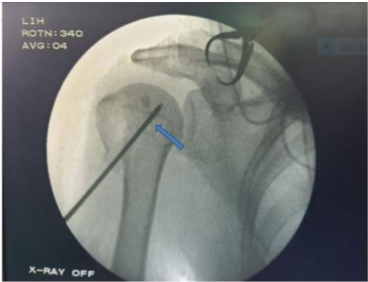Functional Outcome of Proximal Humerus Fracture Operated with Deltopectoral Approach v/s Deltoid Splitting Approach
Main Article Content
Abstract
Introduction: Upper end humerus fractures can be considered one of the common causes of morbidity. Displaced fractures do require operative stabilization. Open reduction and internal fixation are common methods used for head salvage purposes. Locking plate is the usual choice of implant for head-preserving surgeries. Proximal humerus can be operated by two basic approaches, conventional deltopectoral and lateral deltoid-split approach. Materials and methods: The study was conducted from May 2020 to May 2022 in tertiary care medical college hospital. The study was prospective involving 40 patients. Patients were randomly selected (20 in each group). Results were evaluated by the Constant score system. Results: The study showed female preponderance. Better clinical and functional outcome was observed in patients treated by deltoid split approach. Conclusions: Deltoid split approach is better than Deltopectoral approach for better clinical and functional outcomes in proximal humerus fractures. Deltoid split approach is better in terms of less operative time, less blood loss, less immobilization time, and early resumption of activities of daily living for a patient.
Article Details
References
Wild JR, DeMers A, French R, et al.: Functional outcomes for surgically treated 3- and 4-part proximal humerus fractures. Orthopedics. 2011, 34:629-33. 10.3928/01477447-20110826-14
Owsley KC, Gorczyca JT: Fracture displacement and screw cutout after open reduction and locked plate fixation of proximal humeral fractures. J Bone Joint Surg Am. 2008, 90:233-40. 10.2106/jbjs.f.01351
Sudkamp N, Bayer J, Hepp P, et al.: Open reduction and internal fixation of proximal humeral fractures with use of the locking proximal humerus plate. Results of a prospective, multicenter, observational study. J Bone Joint Surg Am. 2009, 91:1320-8. 10.2106/jbjs.h.00006
Agudelo J, Schurmann M, Stahel P, et al.: Analysis of efficacy and failure in proximal humerus fractures treated with locking plates. J Orthop Trauma. 2007, 21:676-81. 10.1097/bot.0b013e31815bb09d
Neer CS 2nd: Displaced proximal humeral fracture. I. Classification and evaluation. J Bone Joint Surg Am. 1970, 52:1077-89.
Hoppenfeld S, deBoer Piet: Surgical Exposures in Orthopaedics:The Anatomic ApproachThe Shoulder. p 5-38.
Robinson CM, Murray IR: The extended deltoid-splitting approach to the proximal humerus: Variations and extensions. J Bone Joint Surg Br. 2011, 93:387-92. 10.1302/0301-620x.93b1.25702
Gardner MJ, Griffith MH, Dines JS, Briggs SM, Weiland AJ, Lorich DG: The extended anterolateral acromial approach allows minimally invasive access to the proximal humerus. Clin Orthop Relat Res. 2005, 123:9. 10.1097/01.blo.0000152872.95806.09
Constant CR, Murley AH: A clinical method of functional assessment of the shoulder. Clin Orthop Relat Res. 1987, 160:4.
Robinson CM, Khan L, Akhtar A, Whittaker R: The extended deltoid-splitting approach to the proximal humerus. J Orthop Trauma. 2007, 21:657-62. 10.1097/bot.0b013e3180ce833e
Robinson CM, Khan LA, Akhtar MA: Treatment of anterior fracture-dislocations of the proximal humerus by open reduction and internal fixation. J Bone Joint Surg Br. 2006, 88:502-8. 10.1302/0301-620x.88b4.17195
Robinson CM, Akhtar A, Mitchell M, Beavis C: Complex posterior fracture-dislocation of the shoulder. Epidemiology, injury patterns, and results of operative treatment. J Bone Joint Surg Am. 2007, 89:1454-66. 10.2106/JBJS.F.01214
Wu CH, Ma CH, Yeh JJ, Yen CY, Yu SW, Tu YK: Locked plating for proximal humeral fractures: Differences between the deltopectoral and deltoid-splitting approaches. J Trauma. 2011, 71:1364-70. 10.1097/ta.0b013e31820d165d
Hepp P, Theopold J, Voigt C, Engel T, Josten C, Lill H: The surgical approach for locking plate osteosynthesis of displaced proximal humeral fractures influences the functional outcome. J Shoulder Elbow Surg. 2008, 17:21-8. 10.1016/j.jse.2007.03.029
Moonot P, Ashwood N, Hamlet M: Early results of three- and four-part fractures of proximal humerus using the PHILOS plate system. J Bone Joint Surg Br. 2007, 89:1206-9. 10.1302/0301-620x.89b9.18528
Isiklar Z, Kormaz F, Gogus A, Kara A: Comparison of deltopectoral versus lateral deltoid split approach in operative treatment of proximal humeral fractures. J Bone Joint Surg Br. 2010, 92:352.
Gardner MJ, Boraiah S, Helfet DL, Lorich DG: The anterolateral acromial approach for fractures of the proximal humerus. J Orthop Trauma. 2008, 22:132-7. 10.1097/bot.0b013e3181589f8c
Rouleau DM, Balg F, Benoit B, Leduc S, Malo M, Vézina F, Laflamme GY. Deltopectoral vs. deltoid split approach for proximal HUmerus fracture fixation with locking plate: a prospective RAndomized study (HURA). J Shoulder Elbow Surg. 2020 Nov;29(11):2190-2199. doi: 10.1016/j.jse.2020.06.020. Epub 2020 Jul 7. PMID: 32650077.
Xie L, Zhang Y, Chen C, Zheng W, Chen H, Cai L. Deltoid-split approach versus deltopectoral approach for proximal humerus fractures: A systematic review and meta-analysis. Orthop Traumatol Surg Res. 2019 Apr;105(2):307-316. doi: 10.1016/j.otsr.2018.12.004. Epub 2019 Mar 14. PMID: 30878231.

